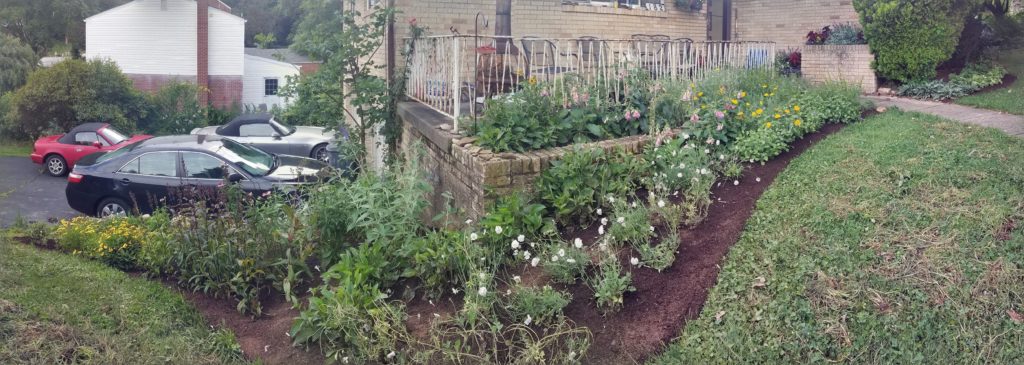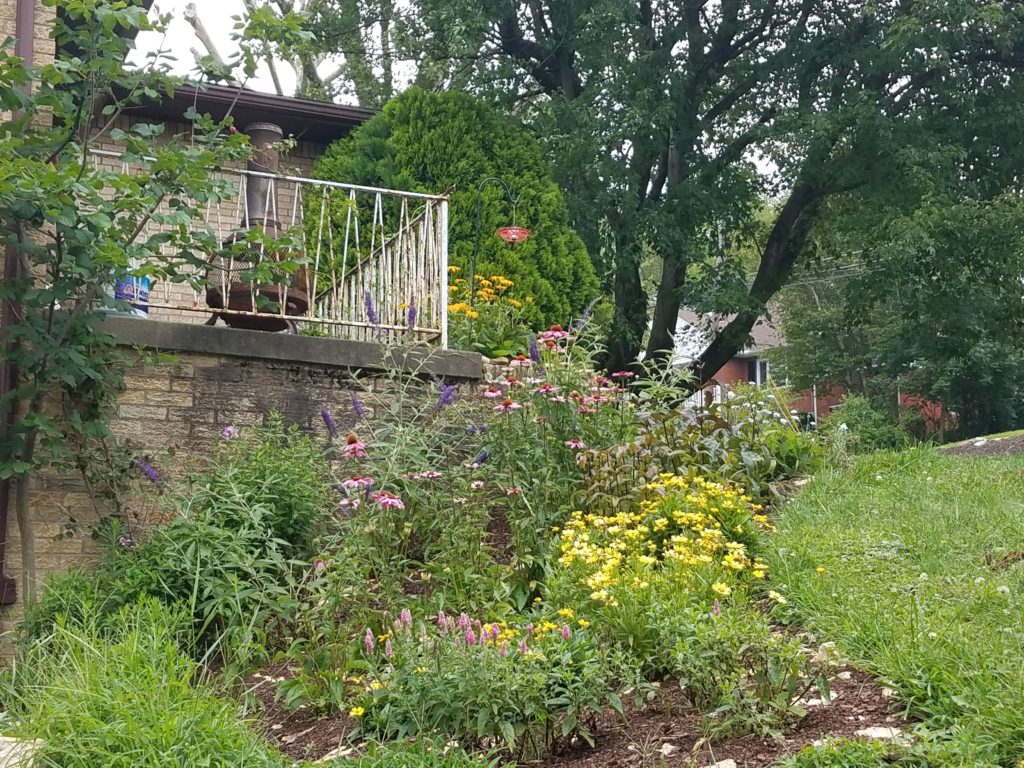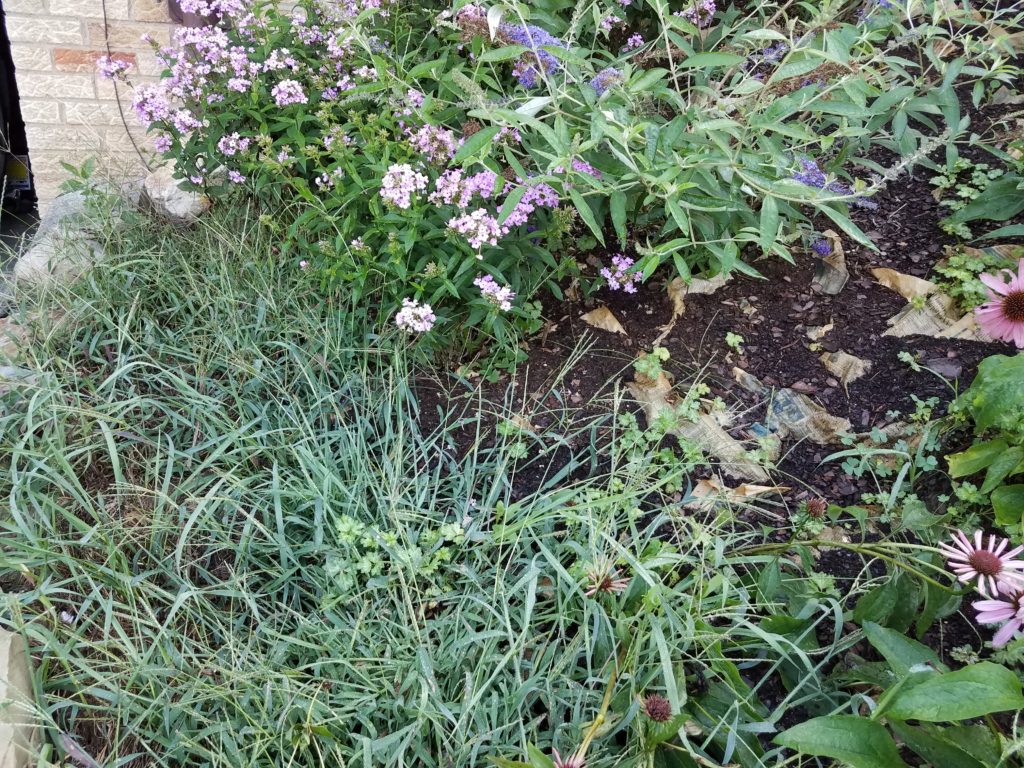I spend a good bit of time in my garden, weeding more than anything else, it seems. A year or so ago, Christian suggested that I use a weed barrier so I wouldn’t have to work as hard. I imagined he was talking about a layer of plastic, and I was naturally appalled. I dismissed his suggestion out of hand and went back to weeding, even though it is a battle I eventually lose every year.
It didn’t even occur to me that there were options outside of putting a layer of plastic in my garden until not one, but two of my coworkers suggested the alternate method of layering newspaper and mulch. Both of them told me about how their mothers and/or grandmothers did it, and I was intrigued. I started doing some research into techniques and found a wealth of information on step-by-step processes and tips for success. Then I asked my family to start saving newspapers for me.

Traditional weed barriers
Plastic sheeting is the only thing I thought of when Christian suggested I put down a weed barrier. I have seen it used by residential neighbors and municipalities alike. In fact, I have helped pull it out of the ground in a fall volunteer session at a county garden, and I quickly learned that it is very difficult to get every last scrap of it because it tears so easily (and must be stapled into the ground in the first place.) To its credit, it does cut down on the need for weeding, and it holds moisture in the ground, which helps reduce the need for excessive watering during dry spells. However, since it is made of plastic, it reduces oxygen flow to anything beneath it (both weeds and desired landscape plants). It should go without saying that adding such an impermeable layer to the garden is also detrimental to any ground-dwelling insects and makes it harder for grub-eating birds to feed.
The other traditional option is landscape fabric, which breathes better than plastic sheeting, allowing oxygen and moisture to circulate. I don’t have any direct experience with this fabric, but I have heard anecdotes about how it can tear, is difficult to pull up (again with the staples), and that weeds are more likely to grow through it than through the plastic sheeting. [1] Most frequently this option is synthetic, but my research did turn up evidence of biodegradable landscape fabric, which appears to be a nice alternative to the synthetic version. Some initial price comparisons online indicate that the biodegradable option may be less expensive, but it’s a safe assumption that it will need to be installed more often simply by nature of the fact that it is designed to break down, while the synthetic version is designed to last.
Sustainable Alternative
Newspaper, on the other hand, is free (outside of the subscription, of course), biodegradable, enriches the soil, and attracts earthworms, which are also beneficial for churning and enriching the soil. I was concerned about putting down a barrier of any kind in my garden, lest any ground-dwelling insects be unable to get in or out. However, I asked my aunt (the one with the garden center), and she said that bees would be able to get through it if they needed to.
Here is the general process, as described on a number of blogs: [2],[3],[4],[5]
- Weed the area lightly or thoroughly (depending on the source)
- Wet the ground
- Lay out the newspaper (anywhere from two to ten layers, depending on the source)
- Wet the newspaper
- Cover with at least three inches of mulch

My Experience
It took me an entire weekend to complete this project. Christian was out of town the first weekend of July, so I spent all day Saturday pulling weeds (not too thoroughly, as one site insists, but enough to clear the area) and all day Sunday putting down newspaper and mulch. The process took such a long time because the garden is so big (about 250 square feet), the plants are close together (requiring a lot of layering with small pieces of newspaper), and half of the garden is on a hill (meaning that it was difficult to keep everything from sliding out of place).
On Saturday after I had finished weeding, the skies opened up to the point where our area had significant flash flooding, and I almost didn’t make it back from the garden center with my mulch. Fortunately that meant that the ground was nice and wet for laying the paper on Sunday.
My mother-in-law collected a huge amount of newspaper for me, but the area I needed to cover is pretty sizeable, and I was still afraid of running out. I used two layers of newspaper, but I needn’t have rationed it so carefully. I had enough left over that I could have used more and probably made it more effective. On Sunday while I was laying the paper, I worked in a consistent rain drizzle, so I didn’t have to go through with the hose and wet the paper after laying it out either. The weather took an active part in what I needed all weekend, which was very convenient.
I did not have enough mulch for three inches. Although I bought four huge bags, I barely had enough to cover the newspaper. I am shocked at how much of the mulch has stayed in place over the last six weeks, including on the steep slope in the lower section of the garden.
I was hoping I could limp through the rest of the season on that little bit of newspaper and mulch without a touch-up, and it appears to be working surprisingly well. I didn’t have enough mulch to cover the whole garden that weekend, and the difference between the area with the newspaper and without is striking. Honestly, I’m surprised Christian even knows where the garden ends when he mows the lawn.

As for the newspaper, it’s not a perfect solution, but it has made my life much easier. I have some bits of crab grass and buttercups coming up between the gaps in the paper edges (or creating their own holes directly through the thin sheets), so I have taken to pulling any weeds that do pop up. The thing that really surprises me is how easily the weeds come out now as compared to before. I think what is happening is that the weeds are running their roots closer to the surface, along the space between the ground and the newspaper, thinking they’re deeper underground than they are. Since they spread out just below the surface of the paper (and the paper holds in much more moisture, making the ground softer), they’re much easier to uproot.
As for the mulch, it is not cheap, and I bought several (plastic) bags of it, which I was not thrilled to do. However, I recently discovered that I can get mulch delivered in bulk, so that will be a more sustainable and affordable option in the future. Speaking of the future, I’m currently saving up cardboard boxes to lay down before the winter for a new patch of garden I plan to dig out for some milkweed next year.
Have you used any kind of weed barriers in your garden? How have they worked out? I’d like to hear the ups and downs of your gardening experiences.
Thanks for reading!
[1] https://www.hunker.com/13404739/landscape-fabric-vs-plastic
[2] https://www.agardenforthehouse.com/2013/05/how-to-smother-weeds-with-newspaper/
[3] https://www.getgreenbewell.com/newspaper-prevents-weeds-in-the-garden/
[4] https://kaseytrenum.com/5-ways-newspaper-beats-landscaping-fabric-for-flowerbeds/
[5] https://www.gracegardenandhomestead.com/prevent-weeds-with-newspaper/
6 Comments
Charles Korey · August 18, 2019 at 3:47 pm
have plenty of newspaper if you need more.
Alison · August 19, 2019 at 10:38 am
Thanks Chuck! I will probably need a ton next spring 🙂
John rozborski · August 18, 2019 at 8:01 pm
I have used a variety of mulches and barriers over the years. Old newspapers, are simply another uber cycling option that was common back when I was born a po’ black chil during the depression. Like any of the mulch/barrier options, their efficacy is upon the depth of coverage and your dedication to perpetual upkeep. Regardless of system, I find I need to walk my gardens daily to (very easily) uproot the persistent and pernicious weeds that defy the barriers and attempt to overtake my gardens. Without diligence, sometimes they win. They won this year. For the record, buttercups are evil. Also, the benefits of mulching are cumulative. Each year, your gardens will become easier to cultivate and to control (prevent and remove) weeds. Finally, please ask your Aunt, “what bees need to burrow into the ground?”
Alison · August 19, 2019 at 10:49 am
I have found that upkeep is so much easier this year with even just the thin layers of newspaper and mulch in my garden. I tend to go around and pull little weeds at least once a week, more often if I can manage. Last year was rough because I didn’t use any weed barrier and couldn’t keep up with it all. And you’re right – it has been getting easier to weed each successive year.
As for ground-dwelling insects, there are many, but if we’re talking about bees specifically, miner bees are the ones that typically live in the ground in gardens and lawns. They’re similar in appearance to honey bees, docile, and don’t stay long. I just wanted to make sure I wasn’t keeping anyone in or out by layering newspaper and mulch too heavily… but I guess if buttercups can poke through, so can bees.
https://newgarden.com/notes/ground-nesting-bees
Galen · August 19, 2019 at 10:55 am
We used newspaper and mulch a few years ago. We only did a few layers, as we also have large areas to cover, and the mulch was a chipped up tree from my in-laws. It worked fairly well, but we didn’t keep up with weeding, and now 2 years later, the newspaper and mulch are completely gone. Every year, I tell myself I’ll do a better job of weeding and general yard maintenance, and every year I get worse at it.
Alison · August 19, 2019 at 11:02 am
I get it… as my garden expands (as it has every year), I have less time/energy to put into maintenance in any one area.
Can I ask about the mulched tree from your in-laws? First of all, awesome job on the reuse 😀
Do you know someone with a chipper (or can you rent one)? We have a ton of brush to clear in our back yard in the coming weeks, and I’m trying to figure out what to do with it. I would love to be able to turn it all into mulch and put those nutrients back into our soil.